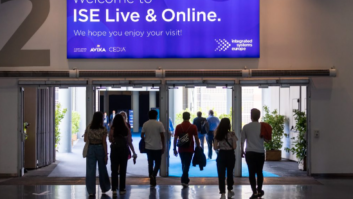
Digital Signage has become an integral part of the modern urban landscape, both indoors and out, but the days of passive content are over. In 2020, the experts believe dynamic content will come to the fore. Here, Brigit Jackson, commercial director of visual solutions at Sharp, looks at the emerging trend for dynamic content on digital signage and its role in the post-COVID world…
The digital signage market is at an exciting point in its evolution – it has grown rapidly in the last few years as solutions have become more affordable and businesses embark on digital transformation strategies to combine offline and online experiences.
In terms of hardware, the large format market is expected to expand at a compound annual growth rate of eight per cent by the end of 2023 and we have seen technological leaps in resolution with 4K and even 8K screens available able to produce images at a higher resolution than the human eye can capture. Over the course of August 2019, partners from Sharp’s Open Architecture Platform were surveyed online and via a series of phone interviews to combine their observations and predictions for the digital signage market and to identify the upcoming trends for the year ahead.
Here, Birgit Jackson discusses these predictions and considers how they will intersect with the new normal after COVID-19…
The rise of dynamic content
Our partners expect dynamic content – localised, real-time content that changes based on the audience or location, like the weather or the news – to appear most widely on digital signage screens in 2020.
There are a number of key trends those surveyed believe will have an impact on the evolution of digital signage in the coming few years. 59 per cent of those surveyed believe that Audience Measurement will be a key driver for many businesses, followed by audience recognition (41 per cent) and even voice-based interaction (35 per cent). Followed closely by passive content, more traditional forms of images and video that fit the digital signage space and include promotions, inspirational messages and information.
Our partners agree that timing will be key in understanding what messaging works best and in which environment. For example, commuters stuck in traffic jams have more time to absorb digital signage messaging during rush hour than at other times of the day. Similarly, people arriving 10 minutes early for a meeting have more time in reception to absorb longer-form content on screens.
Interactive content is likely to be less prevalent and we expect interactive technology to play a role in specialist signage applications. Interactive can work really well with applications where it can be used effectively such as wayfinding or catalogues.
Digital signage and the post-COVID retailer
Michael Bailly, head of global business development at Cenareo, a digital signage platform provider that develops solutions for managing digital signage in software-as-a-service (SaaS) mode, believes retailers in particular need to use digital signage more intuitively to offer the customer a unique experience and face down the challenge of e-commerce.
“The high street has a problem. With e-commerce, the consumer has unlimited choice, availability, convenience and price, plus online retailers can identify consumers’ tastes and preferences, and target them more effectively with their advertising,” Bailly explains. “Meanwhile, the high street is a passive set-up, and to survive it must offer the customer experience that e-commerce cannot – a physical experience – it cannot compete on the same grounds as e-commerce. It’s all about emotion, so the high street must move from ‘one-to-many’ signage to one-to-one, personalised signage, using whatever device is required to achieve that.”
This dynamic content will be especially important as retail reacts to the lifting of COVID-19 lockdown measures. The need to appeal directly to individual shoppers is heightened in the context of greatly reduced footfall as the pubic continuous to observe social distancing and, in some cases, shielding. Retailers will need to rely on engaging, one-to-one personalised signage to increase sales.







